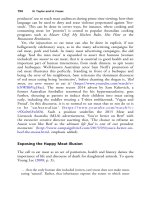The palgrave international handbook of a 208
Bạn đang xem bản rút gọn của tài liệu. Xem và tải ngay bản đầy đủ của tài liệu tại đây (35.46 KB, 1 trang )
Collecting Wildlife
Angus Nurse
Introduction
Animal abuse is often characterised as intentional cruelty and direct harm
caused to live animals (Ascione 1993; Conboy-Hill 2000; Daugherty 2005;
Schaffner 2011), particularly in respect of unnecessary suffering and the
illegal exploitation of animals. The ecological justice and species justice
perspectives of green criminology (Beirne 2007; Benton 1998; White
2008) contend that justice systems need to do more than just consider
anthropocentric notions of detection, apprehension and punishment; they
should also consider how effective justice systems can provide protection and
redress for other species (Benton 1998; White 2008). Green criminological
scholarship has, thus, already paid attention to theoretical questions of
whether, how and to what extent justice systems deal with crimes against
animals and has begun to conceptualise policy perspectives that can provide
effective contemporary species justice alongside mainstream criminal justice.
This chapter considers these issues but is primarily concerned with explanations for crimes against animals. In particular it examines collecting as animal
abuse and activity encompassing both direct and indirect harm.
Animal abuse is significantly influenced by masculinities (Groombridge
1998), often involving the exercise of male power (frequently patriarchal) over
A. Nurse (*)
Middlesex University School of Law, London, United Kingdom
e-mail:
© The Author(s) 2017
J. Maher et al. (eds.), The Palgrave International Handbook of Animal
Abuse Studies, DOI 10.1057/978-1-137-43183-7_10
203









